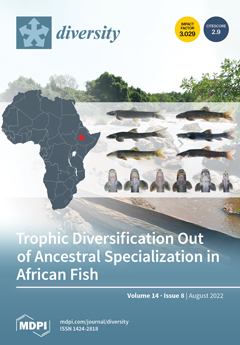Carica papaya L. (
family: Caricaceae), also known as ‘papaya,’ is a tropical American fruit tree. Due to the bioactive components (carpaines, BITC, benzyl glucosinolates, latex, papain, zeaxanthin, choline, etc.) in its seeds, leaves, and fruits, it is revered for its excellent
[...] Read more.
Carica papaya L. (
family: Caricaceae), also known as ‘papaya,’ is a tropical American fruit tree. Due to the bioactive components (carpaines, BITC, benzyl glucosinolates, latex, papain, zeaxanthin, choline, etc.) in its seeds, leaves, and fruits, it is revered for its excellent antioxidant, digestive, and nutraceutical benefits. Papayas are high in vitamins A, B, C, E, and K, folate, pantothenic acid, zeaxanthin, lycopene, lutein, magnesium, copper, calcium, and potassium. Being rich in fiber, antioxidants, and vitamin C, it lowers the cholesterol in the arteries; prevents arthritis; reduces aging, cancer, macular degradation, risk of cardiovascular diseases, and stress; increases platelet count; controls dengue fever; facilitates digestion, and lowers body weight. Papaya leaf extract, with many in vitro and case studies in combination therapies with modern medicine, especially for cancers and many other viral diseases, has been found to be an efficient cure. Humans have cultivated papaya cultivars for millions of years because of their significant commercial, medicinal, and agronomic value. Several reports have been published on the genetic modification of papaya for resistance to abiotic (herbicide, Al toxicity, etc.) and biotic stressors (PRSV, mites, Phytophthora, etc.), delaying ripening, and improving shelf life. However, most of these traits have not been introduced globally to all commercial papaya varieties. Unraveling the genetics of papaya has shed light on various domestication impacts, evolutionary patterns, and sex determination in fruit tree crops. It also serves as a potential step toward developing new cultivars to fight climate-oriented stress. Furthermore, extensive research on the stability of the ‘transgene’ across generations, and the ‘yield-penalty’ caused by the transgene, is required. Thus, meticulous crop improvement research on commercial papaya cultivars is necessary for long-term food and health security. This review article encompasses information on the traditional and modern medicinal uses, nutritional properties, phytochemistry, diseases and etiology, post-harvest measures, genomics, biotechnological strategies (for papaya improvement), and value-added products of papaya for food and health security.
Full article





